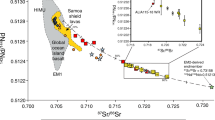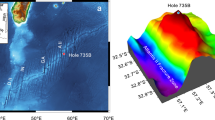Abstract
Rocks in the Earth's uppermost sub-oceanic mantle, known as abyssal peridotites, have lost variable but generally large amounts of basaltic melt, which subsequently forms the oceanic crust1,2. This process preferentially removes from the peridotite some major constituents such as aluminium, as well as trace elements that are incompatible in mantle minerals (that is, prefer to enter the basaltic melt), such as the rare-earth elements3,4. A quantitative understanding of this important differentiation process has been hampered by the lack of correlation generally observed between major- and trace-element depletions in such peridotites. Here we show that the heavy rare-earth elements in abyssal clinopyroxenes that are moderately incompatible are highly correlated with the Cr/(Cr + Al) ratios of coexisting spinels. This correlation deteriorates only for the most highly incompatible elements—probably owing to late metasomatic processes. Using electron- and ion-microprobe data from residual abyssal peridotites collected on the central Indian ridge, along with previously published data, we develop a quantitative melting indicator for mantle residues. This procedure should prove useful for relating partial melting in peridotites to geodynamic variables such as spreading rate and mantle temperature.
This is a preview of subscription content, access via your institution
Access options
Subscribe to this journal
Receive 51 print issues and online access
$199.00 per year
only $3.90 per issue
Buy this article
- Purchase on Springer Link
- Instant access to full article PDF
Prices may be subject to local taxes which are calculated during checkout



Similar content being viewed by others
References
Hess, H. H. in Petrologic Studies (eds Engel, A. E. J., James, H. L. & Leonard, B. F.) 599–620 (Burlington Volume, Geological Society of America, Boulder, 1962).
Bonatti, E. Ultramafic rocks from the Mid-Atlantic ridge. Nature 219, 363–364 (1968).
Johnson, K. T. M., Dick, H. J. B. & Shimizu, N. Melting in the oceanic upper mantle; an ion microprobe study of diopsides in abyssal peridotites. J. Geophys. Res. 95, 2661–2678 (1990).
Johnson, K. T. M. & Dick, H. J. B. Open system melting and temporal and spatial variation of peridotite and basalt at the Atlantis II fracture zone. J. Geophys. Res. 97, 9219–9241 (1992).
Dick, H. J. B. & Natland, J. H. Late-stage melt evolution and transport in the shallow mantle beneath the East Pacific Rise. Proc. ODP Sci. Res. 147, 103–134 (1996).
Ross, K. & Elthon, D. Extreme incompatible trace-element depletion of diopside in residual mantle from south of the Kane F.Z. Proc. ODP Sci. Res. 153, 277–284 (1997).
Dick, H. J. B., Fisher, R. L. & Bryan, W. B. Mineralogic variability of the uppermost mantle along mid-ocean ridges. Earth Planet. Sci. Lett. 69, 88–106 (1984).
Michael, P. J. & Bonatti, E. Peridotite composition from the North Atlantic; regional and tectonic variations and implications for partial melting. Earth Planet. Sci. Lett. 73, 91–104 (1985).
Bodinier, J. L., Vasseur, G., Vernieres, J., Dupuy, C. & Fabries, J. Mechanisms of mantle metasomatism: geochemical evidence from the Lherz orogenic peridotite. J. Petrol. 31, 597–628 (1990).
Kelemen, P. B., Shimizu, N. & Salters, V. J. M. Extraction of mid-ocean-ridge basalt from the upwelling mantle by focused flow of melt in dunite channels. Nature 375, 747–753 (1995).
Seyler, M. & Bonatti, E. Regional-scale melt-rock interaction in lherzolitic mantle in the Romanche fracture zone (Atlantic Ocean). Earth Planet. Sci. Lett. 146, 273–287 (1997).
Suhr, G. Melt migration under oceanic ridges: inferences from reactive transport modelling of upper mantle hosted dunites. J. Petrol. 40, 575–599 (1999).
Pearce, J. A., Barker, P. F., Edwards, S. J., Parkinson, I. J. & Leat, P. T. Geochemistry and tectonic significance of peridotites from the South Sandwich arc-basin system, South Atlantic. Contrib. Mineral. Petrol. 139, 36–53 (2000).
Suhr, G., Seck, H. A., Shimizu, N., Günther, D. & Jenner, G. Infiltration of refractory melts into the lowermost oceanic crust: evidence from dunite- and gabbro-hosted clinopyroxenes in the Bay of Islands Ophiolite. Contrib. Mineral. Petrol. 131, 136–154 (1998).
Batanova, V. G., Suhr, G. & Sobolev, A. V. Origin of geochemical heterogeneity in the mantle peridotites from the Bay of Islands Ophiolite, Newfoundland, Canada; ion probe study of clinopyroxenes. Geochim. Cosmochim. Acta 62, 853–866 (1998).
Baker, M. B. & Stolper, E. M. Determining the composition of high-pressure mantle melts using diamond aggregates. Geochim. Cosmochim. Acta 58, 2811–2827 (1994).
Niu, Y. & Hekinian, R. Spreading-rate dependence of the extent of mantle melting beneath ocean ridges. Nature 385, 326–329 (1997).
Bender, J. F., Langmuir, C. H. & Hanson, G. N. Petrogenesis of basalts from the Tamayo Region, East Pacific Rise. J. Petrol. 25, 231–254 (1984).
Natland, J. H. & Melson, W. G. Composition of basaltic glasses from the East Pacific Rise and Siqueros fracture zone, near 9 degrees N. Init. Rep. DSDP 54, 705–724 (1980).
Ghose, I., Cannat, M. & Seyler, M. Transform fault effect on mantle melting in the MARK area (Mid-Atlantic Ridge south of the Kane transform). Geology 24, 1139–1142 (1996).
Hellebrand, E., Snow, J. E. & Mühe, R. Mantle melting beneath the Gakkel Ridge (Arctic Ocean): abyssal peridotite spinel compositions. Chem. Geol. (in the press).
Klein, E. M. & Langmuir, C. H. Global correlations of ocean ridge basalts with axial depth and crustal thickness. J. Geophys. Res. 92, 8089–8115 (1987).
Dick, H. J. B. Abyssal peridotites, very slow spreading ridges and ocean ridge magmatism. Geol. Soc. Spec. Publ. 42, 71–105 (1989).
Anders, E. & Grevesse, N. Abundances of the elements: meteoric and solar. Geochim. Cosmochim. Acta 53, 197–214 (1989).
Hart, S. R. & Dunn, T. Experimental cpx/melt partitioning of 24 trace elements. Contrib. Mineral. Petrol. 113, 1–8 (1993).
Sobolev, A. V. & Shimizu, N. Extremely depleted magmas and oceanic mantle permeability. Dokl. Akad. Nauk 326, 354–360 (1992).
Shimizu, N., Semet, M. P. & Allegre, J. C. Geochemical applications of quantitative ion microprobe analysis. Geochim. Cosmochim. Acta 42, 1321–1334 (1978).
Jochum, K. P. et al. The preparation and preliminary characterisation of eight geological MPI-DING standard reference glasses for in-situ microanalysis. Geostandards Newsl. 24, 87–133 (2000).
Hellebrand, E., Snow, J. E. & Hofmann, A. W. Garnet-field melting and late-stage refertilization in ‘residual’ abyssal peridotites from the Central Indian Ridge. J. Petrol. (submitted).
Acknowledgements
We thank R. Fisher who originally collected these samples, P. Hoppe and A. Besmehn for their assistance on the Mainz ion probe, N. Shimizu and G. Layne on the WHOI ion probe, and G. Suhr for letting us use his critical melting algorithm. Comments by G. Suhr, A. Sobolev and J. Lassiter helped to improve the manuscript. We thank E. Klein and P. Asimov for formal reviews.
Author information
Authors and Affiliations
Corresponding author
Rights and permissions
About this article
Cite this article
Hellebrand, E., Snow, J., Dick, H. et al. Coupled major and trace elements as indicators of the extent of melting in mid-ocean-ridge peridotites. Nature 410, 677–681 (2001). https://doi.org/10.1038/35070546
Received:
Accepted:
Issue Date:
DOI: https://doi.org/10.1038/35070546
This article is cited by
-
Petrological and geochemical constraints of mantle peridotites on the magma-starved Yap Arc formed by ultra-slow subduction
Contributions to Mineralogy and Petrology (2023)
-
Trace elements in abyssal peridotite olivine record melting, thermal evolution, and melt refertilization in the oceanic upper mantle
Contributions to Mineralogy and Petrology (2023)
-
Heterogeneous mantle beneath the Neo-Tethys Ocean revealed by ultramafic rocks from the Xiugugabu Ophiolite in the Yarlung-Tsangpo Suture Zone, southwestern Tibet
Contributions to Mineralogy and Petrology (2023)
-
Peridotites with back-arc basin affinity exposed at the southwestern tip of the Mariana forearc
Progress in Earth and Planetary Science (2022)
-
Multistage evolution of subcontinental lithospheric mantle of northwestern Deccan volcanic province, India: Constraints from the ultramafic xenoliths in alkali magma
Journal of Earth System Science (2022)
Comments
By submitting a comment you agree to abide by our Terms and Community Guidelines. If you find something abusive or that does not comply with our terms or guidelines please flag it as inappropriate.



